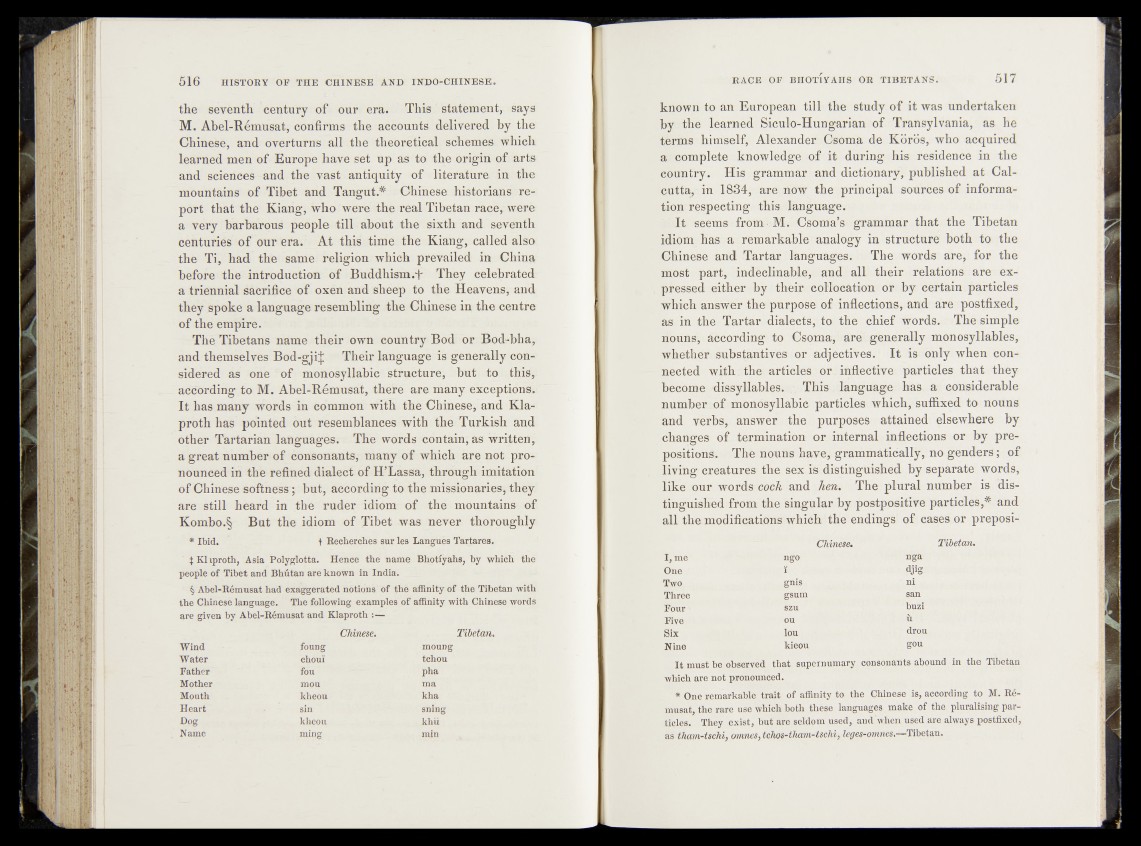
the seventh century of our era. This' statement, says
M. Abel-Rémusat, confirms the accounts delivered by the
Chinese, and overturns all the theoretical schemes which
learned men of Europe have set up as to the origin of arts
and sciences and the vast antiquity of literature iintthe
mountains of Tibet and Tangut.# Chinese historians report
that the Kiang, who were the real Tibetan, race,-were
a very barbarous people till about the sixth and. seventh
centuries of our era. At this time the Kiang, called also*
the Ti, had the same religion which prevailed in China
before the introduction of Buddhism.^ They celebrated
a triennial sacrifice of oxen and sheep to the Heavens»,; and
they spoke a language resembling the Chinese in the centre
of the empire.
The Tibetans name their own country Bod or Bod^bha,
and themselves Bod-gjij: Their language is generally con^
sidered as one of monosyllabic structure, bdt» do this,
according to M. Abel-Rémusat, there are many exceptions.
It has many words in common with the Chinese,! and Klaproth
has pointed out resemblances with th&Jfurkish and
other Tartarian languages. The words as written,
a great number of consonants, many of which are not pronounced
in the refined dialect of H’Lassa, through imitation
of Chinese softness; but, according to the missionaries, they
are still heard in the ruder idiom of thé mountains of
Kombo.§ But the idiom of Tibet was never thoroughly
* Ibid. t Recherches sur les Languës Tartares,
tKliproth, Asia Polyglotta. Hence the name Bhotfyahs, by which thé
people of Tibet and Bhutan are known in India.
§ Abel-Rémusat had exaggerated notions of thé affinity of the Tibetan with
the Chinese language. The following examples of affinity with Chinese words
ere given by Abel-Rémusat and Klaproth :—
Chinese. Tibetan.
Wind foung moung
Water choux tchou
Father fou pha
Mother mou ma
Mouth kheou kha
Heart sin suing
Dog kheou khii
Name ming min
known to an European till the study of it was undertaken
by the learned Siculo-Hungarian of Transylvania, as he
terms hi msel^jAlexander Csoma de Koras, who acquired
a complete knowledge of it during his residence in the
country. His grammar and dictionary, published at Calcutta,
in 1884, are now the principal sources of informa-»
tion rçspectingr this language.
" It seems from^M. Csoma’si grammar that the Tibetan
idiom has a remarkable analogy ml structure both to the
Chinese and Tartar languages.v. The words are, for the
most part, indeclinable, and all their relations are expressed
either by their collocation or by certain particles
which answer the purpose of inflections, and are postfixed,
as f in the Tartar dialects, , to the chief words. The simple
nouns, according to Csoma* are generally monosyllables,
whether substantives.or adjectives.■ It is-only when connected,
wjth. the. articles or inflective particles that they
become 'dissyllables.;- /. This language has a considerable
number;of monosyllabic particles which, suffixed to nouns
and verbs, answer the purposes attained elsewhere by
changes of termination or. internal inflections or by prepositions.
The nouns have, grammatically, no genders ; of
living creatures the sex is distinguished by separate words,
like our words cock and hen. The plural number is distinguished
from the singular by postpositive particles,* and
all the modifications which the endingà of cases or preposi-
Chinese. Tibetan.
I, me ngo nga
One ï - f $ig*i
Two gnis ni ;
Three . gsum san
Four ® szu buzi
Five :/ ou ’ • -- ù +
Six Ion . drou
Nine kieou 1 goa
It must be observed that supernumary consonants abound in the Tibetan
which are not pronounced.
* One remarkable trait of affinity to the Chinese is, according to M. R6-
musat, the rare use which both these languages make of the pluralising particles.
They exist, but are seldom used, and'when used are always postfixed,
as tham-tschi, omnes, teJios-tham-tschi, leges~omnes.-—Tibetan.